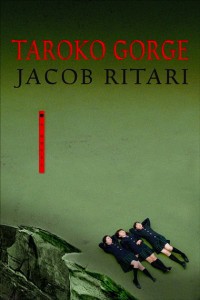“Why should I be so shaken up? Somehow I had never seen a person die in front of me, but I had known plenty to go missing. Some of whom I missed very much. Nice people who talked to me and then the next day were gone without explanation…”—Peter Niels
Forty-six-y ear-old journalist Peter Niels, who has traveled the world since his youthful marriage ended, is touring Taiwan, a country he thoroughly enjoys, when he and his photographer, Josh Pickett, have a day free from professional responsibilities. Deciding to visit the famous Taroko Gorge, they become involved in a strange disappearance. A group of ninth grade Japanese students has come to Taroko for an end-of-the year class trip, and both Niels and Pickett hear three schoolgirls singing as they explore the area in their “sailor-suit” uniforms. Niels falls asleep, and when he awakens, he sees that Pickett has just returned from a sidetrip. Immediately afterward, he hears a Japanese boy and girl calling for some of their fellow students who have not returned from exploring.
ear-old journalist Peter Niels, who has traveled the world since his youthful marriage ended, is touring Taiwan, a country he thoroughly enjoys, when he and his photographer, Josh Pickett, have a day free from professional responsibilities. Deciding to visit the famous Taroko Gorge, they become involved in a strange disappearance. A group of ninth grade Japanese students has come to Taroko for an end-of-the year class trip, and both Niels and Pickett hear three schoolgirls singing as they explore the area in their “sailor-suit” uniforms. Niels falls asleep, and when he awakens, he sees that Pickett has just returned from a sidetrip. Immediately afterward, he hears a Japanese boy and girl calling for some of their fellow students who have not returned from exploring.
Author Jacob Ritari alternates his points of view from Peter Niels to Michiko Kamakuri, one of the schoolgirls on the trip who decided not to go exploring on her own; Tohru Maruyama, the ninth grade Class Representative with whom several of the girls are “in love”; and Det ective Hsien Chao, the stodgy Taiwanese policeman called in to investigate the disappearances. The chaperone of the Japanese trip, Mr. Tanaka, a physical education instructor who became their homeroom teacher, is under great pressure to find the girls and ensure a happy ending.
ective Hsien Chao, the stodgy Taiwanese policeman called in to investigate the disappearances. The chaperone of the Japanese trip, Mr. Tanaka, a physical education instructor who became their homeroom teacher, is under great pressure to find the girls and ensure a happy ending.
In the course of the novel, Ritari delineates many different characters, giving the three missing girls unique characteristics which distinguish them from each other. Since the Japanese characters are all known by both their personal names and their family names, readers will find it useful to keep track of both names for each girl in order to keep from confusing the characters. When a typhoon hits Taiwan before the girls have been found, the tension increases exponentially. Everyone suddenly begins to see everyone else in a new light, and the hidden resentments among the various groups—Taiwanese, Japanese, and Americans—begin to be revealed. Taiwanese Det. Hsien Chao admits he hates the Japanese and does not like Americans. Chaperone Tanaka finds the Taiwanese lazy.
While all the adults are deal ing with the missing students and their own issues, some of the young students left at the campsite are exploring the world of love and sex, and at this point, it may be difficult for some readers not to be reminded of Young Adult fiction. Throughout the emergency, spiritual portents and religious references emerge. A monk from the nearby Buddhist temple appears and offers help, Neils hears a mysterious voice, and the ghost of one of the missing students appears. A mixture of commentary from Catholicism, Buddhism, and other New Age religions adds some spiritual significance to the inner searches which the participants engage in during the crisis.
ing with the missing students and their own issues, some of the young students left at the campsite are exploring the world of love and sex, and at this point, it may be difficult for some readers not to be reminded of Young Adult fiction. Throughout the emergency, spiritual portents and religious references emerge. A monk from the nearby Buddhist temple appears and offers help, Neils hears a mysterious voice, and the ghost of one of the missing students appears. A mixture of commentary from Catholicism, Buddhism, and other New Age religions adds some spiritual significance to the inner searches which the participants engage in during the crisis.
As the author deals with issues of one person’s responsibility for others (or not) and the nature of inner peace vs. guilt, the investigation shows the characters rapidly descending into mistrust and open allegations against others, raising the tension. The resolution comes naturally from the plot and ties up the loose ends without any major surprises.

Told in clean and simple prose, the novel emphasizes plot and the effects of the disappearances on individual characters, though there are few complexities and surprises. Some characters with things to hide reexamine their pasts, while others rationalize their actions in order to move on to new lives. (“Why should I have to be unhappy forever just because of something that happened by accident?” one wonders.) Since the majority of characters are about fourteen, the level of complexity in their lives revolves primarily around puberty, their ability to deal with the pressures of their competitive school lives, and their fear for their missing friends, and though the characters are Japanese, Taiwanese, and American, the different cultural values and behaviors are far less important here and have far less impact on character than what one might expect or hope for in a novel with this setting.
Notes: The author’s photo appears on the Unbridled Books website: http://unbridledbooks.com
The photo of Taroko Gorge is courtesy of the Taiwan Tourism Board. http://articles.sfgate.com
The photo of the Buddhist Temple at Taroko Gorge is from Cultural Tourism Taiwan: http://tour.cca.gov
